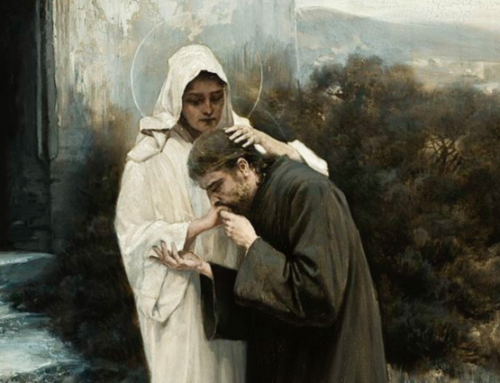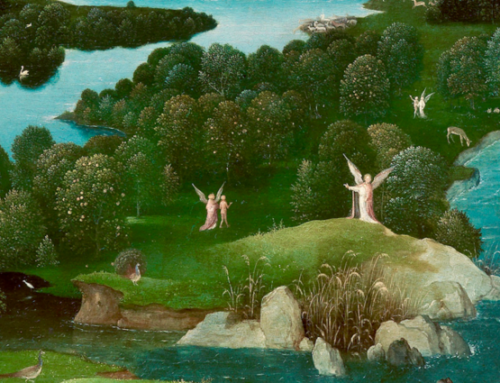 Last month, in an essay entitled “Chesterton Meets the Devil”, I discussed the period of youthful morbidity which characterized Chesterton’s time at the Slade School of Art in the early 1890s. This gloom-laden period inspired “The Diabolist,” one of Chesterton’s darkest and most powerful essays. Published in Tremendous Trifles in 1909, it recounts an episode in which the young Chesterton encountered the devil in the form of one of the devil’s disciples. The “quiet conversation” that he had with this diabolist was the most terrible thing that had ever happened to him, especially one sentence uttered by the diabolist which had haunted him ever since. “It was a sentence so awful that I could not forget it if I would. It was the last sentence spoken, and it was not spoken to me.”
Last month, in an essay entitled “Chesterton Meets the Devil”, I discussed the period of youthful morbidity which characterized Chesterton’s time at the Slade School of Art in the early 1890s. This gloom-laden period inspired “The Diabolist,” one of Chesterton’s darkest and most powerful essays. Published in Tremendous Trifles in 1909, it recounts an episode in which the young Chesterton encountered the devil in the form of one of the devil’s disciples. The “quiet conversation” that he had with this diabolist was the most terrible thing that had ever happened to him, especially one sentence uttered by the diabolist which had haunted him ever since. “It was a sentence so awful that I could not forget it if I would. It was the last sentence spoken, and it was not spoken to me.”
Reading Chesterton’s account, recalling as it does the fin de siècle, the decade of decadence, it is difficult not to feel that the real-life person with whom Chesterton had his terrible conversation was in some sense the ghost of Dorian Gray, the diabolical protagonist of Oscar Wilde’s novel, which had only recently published. “For hours of the day he would talk with me about Milton or Gothic architecture,” Chesterton wrote; “for hours of the night he would go where I have no wish to follow him, even in speculation.”
Discussing their respective creeds in the gloom of the night and by the glow of a bonfire, the diabolist expressed his contempt for morality. As the iconoclastic words were uttered, Chesterton glanced at his face. “He had thrust out his neck as he had a trick of doing; and so brought his face abruptly into the light of the bonfire from below, like a face in the footlights. His long chin and high cheekbones were lit up infernally from underneath; so that he looked like a fiend staring down into the flaming pit.”
As a burst of red sparks from the fire burst past them pyrotechnically, Chesterton sought to exorcise the spirit of darkness with the light of beauty.
“Aren’t those sparks splendid?”
“Yes,” the diabolist conceded.
“That’s all I ask you to admit,” Chesterton continued. “Give me those few red sparks and I will deduce Christian morality.” Elaborating on the philosophy of gratitude that he had only recently embraced as a means of vanquishing his own spirit of darkness, Chesterton told his diabolical interlocutor that it was only the gratitude they learned at their mothers’ knees which enabled them to appreciate the beauty of nature, and that it was only whatever remained of childlike humility which kept their eyes open to the presence of beauty. The flaming flowers of beauty, signified by the red sparks from the fire, were the flowers of virtue. When the virtues fade so will the flowers. “Seduce a woman,” Chesterton told the diabolist, “and the spark will be less red. Be really bad, and they will be to you like the spots on a wallpaper.”
“But shall I not find in evil a life of its own?” the diabolist responded. He conceded, with what Chesterton described as “a horrible fairness of the intellect that made me despair of his soul,” that one of the red sparks would go out with every woman he ruined but that such sacrificial victims were necessary for the experience of “the expanding pleasure of ruin”.
Exasperated to the point of fury, Chesterton accused his satanic acquaintance of worshipping the devil.
“Perhaps,” the diabolist replied, with lethargic detachment. “Only what you call evil I call good.”
Reaching this impasse, the diabolist took his leave. Chesterton went to find his hat in a low, dark hallway where it was hung and once again heard the words of the diabolist. Although his words were inaudible, Chesterton recognized the voice of “one of the vilest” of the diabolist’s associates say that “nobody can possibly know”. It was then that he heard the diabolist utter the “sentence so awful” that Chesterton could not forget it, even if he wished to do so, “the last sentence spoken,” which was not spoken to him. “I tell you I have done everything else,” he heard the diabolist say. “If I do that I shan’t know the difference between right and wrong.”
Chesterton rushed out without daring to pause, passing the fire and not knowing “whether it was hell or the furious love of God”.
The final paragraph of the essay, relating a real-life episode, is so replete with the spirit of the Decadence that it reads like something written in the fiction of Huysmans or Wilde of characters, such as Des Esseintes of Dorian Gray. Truth is so much stranger than fiction and much creepier: “I have since heard that he died: it may be said, I think, that he committed suicide; though he did it with tools of pleasure, not with tools of pain. God help him, I know the road he went; but I have never known or even dared to think what was the place at which he stopped and refrained.”
The Imaginative Conservative applies the principle of appreciation to the discussion of culture and politics—we approach dialogue with magnanimity rather than with mere civility. Will you help us remain a refreshing oasis in the increasingly contentious arena of modern discourse? Please consider donating now.
The featured image (detail) is a German postcard by Hermann Leiser Verlag, Berlin, no. 3152. Photo: Richard-Oswald-Produktion. Bernd Aldor in Das Bildnis des Dorian Gray (Richard Oswald, 1917), an adaptation of Oscar Wilde’s The Picture of Dorian Gray. This file is in the public domain, courtesy of Wikimedia Commons.







Your Chesterton essays are wonderfully entertaining, thanks much
“… it was only the gratitude they learned at their mothers’ knees which enabled them to appreciate the beauty of nature, and that it was only whatever remained of childlike humility which kept their eyes open to the presence of beauty.”
That statement struck me as apocalyptic for our childrens’ future. Parents on their electronic devices with their children invisible to the ones unto which their futures are entrusted. The knee may be offered, but absent is the attention and counsel that will form them to see (and spread) beauty. Sadly, those same parents attempt to spare them from all emotional pain, while being blind that they are the ultimate source of the pain that will eventually come to the surface.